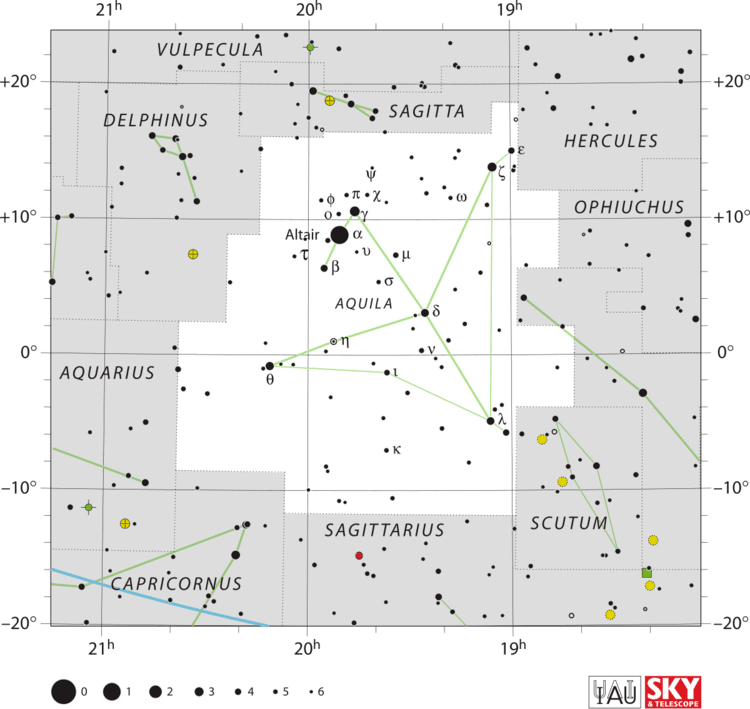 | ||
Zeta Aquilae (ζ Aql, ζ Aquilae) is a double star in the equatorial constellation of Aquila. It has the traditional name Deneb el Okab, meaning "the tail of the eagle". As a third magnitude star, Zeta Aquilae is readily visible with the naked eye. Parallax measurements place it at a distance of approximately 83 light-years (25 parsecs) from Earth.
Contents
Properties
Zeta Aquilae has a stellar classification of A0 Vn, with the luminosity class 'V' indicating is a main sequence star that is generating energy through the nuclear fusion of hydrogen at its core. It has more than double the mass and twice the radius of the Sun, and is radiating more than 39 times the Sun's luminosity. The effective temperature of the star's outer envelope is about 9620 K, which gives it the white hue typical of A-type stars. The estimated age of this star is 50–150 million years.
This star is rotating rapidly, with a projected rotational velocity of 317 km s−1 giving a lower bound on the azimuthal velocity along the equator. As a result, it has a pronounced equatorial bulge, causing the star to assume an oblate spheroidal shape. The equatorial radius is about 30.7% greater than the polar radius. Because of the Doppler effect, this rapid rotation makes the absorption lines in the star's spectrum broaden and smear out, as indicated by the 'n' suffix in the stellar class.
Astronomers use Zeta Aquilae as a telluric standard star. That is, the spectrum of this star is used to correct for telluric contamination from the Earth's atmosphere when examining the spectra of neighboring stars. Observation of this star in the infrared band during the 2MASS survey appeared to reveal excess emission. However, the distribution of this emission couldn't be readily explained by a conjectured disk of circumstellar dust. Instead, the detection was later ascribed to errors caused by saturation of the near-infrared detectors.
This star has two 12th magnitude companions at angular separations of 6.5 and 158.6 arcseconds.
Etymology
It has the traditional names Deneb el Okab, from an Arabic term ذنب العقاب Dhanab Al-uqab meaning "the tail of the eagle", and the Mandarin names Woo and Yuë, derived from and represent the state Wu (吳), an old state was located at the mouth of the Yangtze River, and Yue (越), an old state in Zhejiang province (together with 19 Capricorni or ψ Capricorni in R.H.Allen's version, in Twelve States asterism). According to the R.H. Allen's works, it shares names with ε Aquilae.
In Chinese, 天市左垣 (Tiān Shì Zuǒ Yuán), meaning Left Wall of Heavenly Market Enclosure, refers to an asterism which is represent eleven old states in China which is marking the left borderline of the enclosure, consisting of ζ Aquilae, δ Herculis, λ Herculis, μ Herculis, ο Herculis, 112 Herculis, θ1 Serpentis, η Serpentis, ν Ophiuchi, ξ Serpentis and η Ophiuchi. Consequently, ζ Aquilae itself is known as 天市左垣六 (Tiān Shì Zuǒ Yuán liù, English: the Sixth Star of Left Wall of Heavenly Market Enclosure), represent the states which have mentioned above.
In the catalogue of stars in the Calendarium of Al Achsasi Al Mouakket, this star was designated Dzeneb al Tair (from ذنب الطائر - ðanab aṭ-ṭā’ir), which was translated into Latin as Cauda (Vulturis) Volantis, meaning the eagle's tail.
In culture
The system is depicted in the computer game Descent II.
